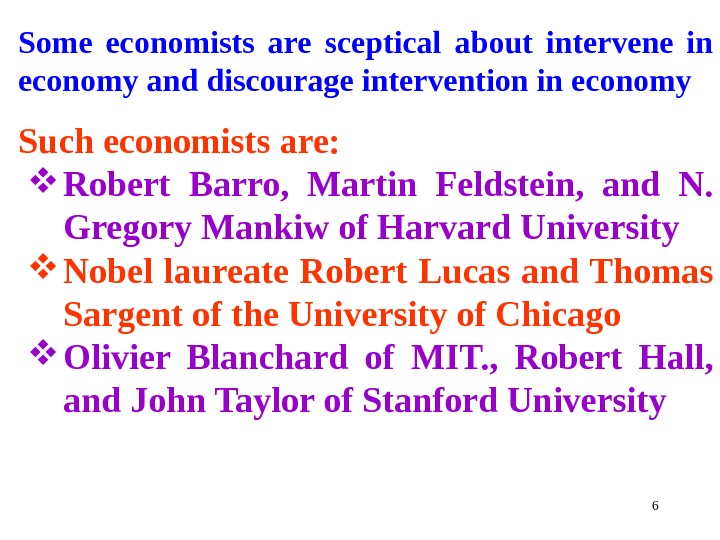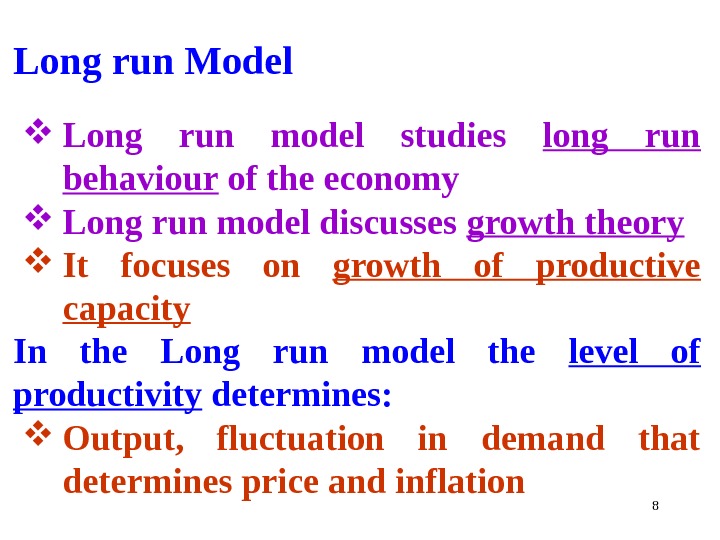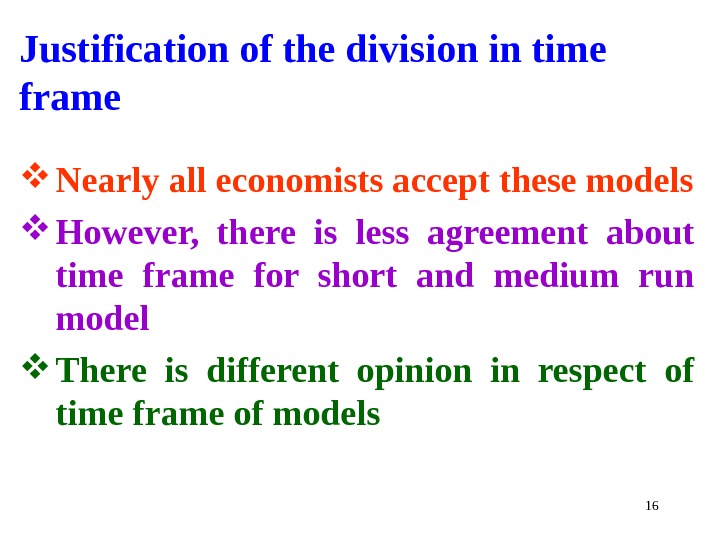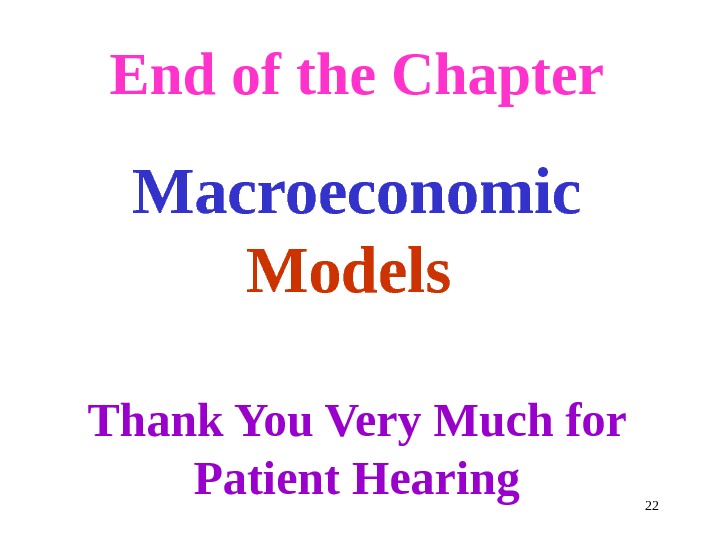CHAPTER II Macroeconomic Models 1 In























- Размер: 222 Кб
- Количество слайдов: 22
Описание презентации CHAPTER II Macroeconomic Models 1 In по слайдам
 CHAPTER II Macroeconomic Models
CHAPTER II Macroeconomic Models
 In developing countries, the development of a well-functioning infrastructure is more important than the development of new technology.
In developing countries, the development of a well-functioning infrastructure is more important than the development of new technology.
 Macroeconomics is concerned with the growth of the economy , and employment and income generation So, it studies the behaviour of the economy as a whole Macroeconomics studies: Significance of total output Rates of inflation and unemployment Booms and recessions Essence of Balance of payments and Exchange rates
Macroeconomics is concerned with the growth of the economy , and employment and income generation So, it studies the behaviour of the economy as a whole Macroeconomics studies: Significance of total output Rates of inflation and unemployment Booms and recessions Essence of Balance of payments and Exchange rates
 Macroeconomics analyses: Short-run behaviour of the economy Medium-run fluctuations of the economy, and Long-run economic growth Macroeconomics analyses short, medium and long run impact of policies like: Consumption and investment policies Changes in wages and prices Monetary and fiscal policies Money stock, budget, interest rates, and the national debt Foreign exchange rate and the trade balance
Macroeconomics analyses: Short-run behaviour of the economy Medium-run fluctuations of the economy, and Long-run economic growth Macroeconomics analyses short, medium and long run impact of policies like: Consumption and investment policies Changes in wages and prices Monetary and fiscal policies Money stock, budget, interest rates, and the national debt Foreign exchange rate and the trade balance
 Objective of macroeconomic analysis are: To understand how the macro-economy works How to make the economy perform better Great macroeconomists suggest to intervene in economy Such economists are as for example: John Maynard Keynes Milton Friedman of the University of Chicago and the Hoover Institution Franco Modigliani and Robert Solow of M. I. T James Tobin of Yale University
Objective of macroeconomic analysis are: To understand how the macro-economy works How to make the economy perform better Great macroeconomists suggest to intervene in economy Such economists are as for example: John Maynard Keynes Milton Friedman of the University of Chicago and the Hoover Institution Franco Modigliani and Robert Solow of M. I. T James Tobin of Yale University
 Some economists are sceptical about intervene in economy and discourage intervention in economy Such economists are: Robert Barro, Martin Feldstein, and N. Gregory Mankiw of Harvard University Nobel laureate Robert Lucas and Thomas Sargent of the University of Chicago Olivier Blanchard of MIT. , Robert Hall, and John Taylor of Stanford University
Some economists are sceptical about intervene in economy and discourage intervention in economy Such economists are: Robert Barro, Martin Feldstein, and N. Gregory Mankiw of Harvard University Nobel laureate Robert Lucas and Thomas Sargent of the University of Chicago Olivier Blanchard of MIT. , Robert Hall, and John Taylor of Stanford University
 2. MACROECONOMIC MODELS Macroeconomics organised in three models Each of these models have different time frame The Models are: Long run model Medium run model Short run model
2. MACROECONOMIC MODELS Macroeconomics organised in three models Each of these models have different time frame The Models are: Long run model Medium run model Short run model
 Long run Model Long run model studies long run behaviour of the economy Long run model discusses growth theory It focuses on growth of productive capacity In the Long run model the level of productivity determines: Output, fluctuation in demand that determines price and inflation
Long run Model Long run model studies long run behaviour of the economy Long run model discusses growth theory It focuses on growth of productive capacity In the Long run model the level of productivity determines: Output, fluctuation in demand that determines price and inflation
 In the long-run: Per capita GDP is constant Per capital in constant, and Full employment is achieved So, if the long-run demand increases : Firms have no possibility to increase supply (because of full employment) Hence, if in the long run demand increases : Output remains unchanged Only price increases Hence, in the long run aggregate supply curve is Vertical (Slide-9)
In the long-run: Per capita GDP is constant Per capital in constant, and Full employment is achieved So, if the long-run demand increases : Firms have no possibility to increase supply (because of full employment) Hence, if in the long run demand increases : Output remains unchanged Only price increases Hence, in the long run aggregate supply curve is Vertical (Slide-9)
 Figure-1: Supply in the Long run growth model P Price Level P 1 P 0 0 Y o Y Output/Income
Figure-1: Supply in the Long run growth model P Price Level P 1 P 0 0 Y o Y Output/Income
 Short run model studies short run behaviour of the economy It analyses level of output and unemployment It analyses quantity of output that firms are willing to supply at a given price level If in short-run demand increases , firms increase supply Firms use this opportunity to achieve gain They keep price unchanged and increase supply So, in short-run aggregate supply curve remains horizontal (Slide-11)
Short run model studies short run behaviour of the economy It analyses level of output and unemployment It analyses quantity of output that firms are willing to supply at a given price level If in short-run demand increases , firms increase supply Firms use this opportunity to achieve gain They keep price unchanged and increase supply So, in short-run aggregate supply curve remains horizontal (Slide-11)
 Figure- 2: Supply in the short run growth model P Price Level P 1 AS 0 Y Output, Income
Figure- 2: Supply in the short run growth model P Price Level P 1 AS 0 Y Output, Income
 Medium run model studies medium run behaviour of of the economy It studies howhow economy grows from short run to long run In the medium run model productive capacity could be increased In medium run growth theory the adjustment process of the economy from the short run to the long run has been discussed. Medium run growth theory begins with the supply side of the economy. It discusses the adjustment mechanism of the aggregate supply and price
Medium run model studies medium run behaviour of of the economy It studies howhow economy grows from short run to long run In the medium run model productive capacity could be increased In medium run growth theory the adjustment process of the economy from the short run to the long run has been discussed. Medium run growth theory begins with the supply side of the economy. It discusses the adjustment mechanism of the aggregate supply and price
 In Figure-3 (Slide-14) illustrates the medium run supply curves Figure-3 shows the long run and short run aggregate supply curve. It has been assumed that in medium run aggregate supply curve rotates counter clockwise. In medium run model the aggregate supply curve transforms with the time from horizontal to vertical curve. During the shift the output as well as the price increase
In Figure-3 (Slide-14) illustrates the medium run supply curves Figure-3 shows the long run and short run aggregate supply curve. It has been assumed that in medium run aggregate supply curve rotates counter clockwise. In medium run model the aggregate supply curve transforms with the time from horizontal to vertical curve. During the shift the output as well as the price increase
 Figure-3: Medium run growth model t 3 t 2 t 1 AS at t = 0 O Y 1 Y Output
Figure-3: Medium run growth model t 3 t 2 t 1 AS at t = 0 O Y 1 Y Output
 Justification of the division in time frame Nearly all economists accept these models However, there is less agreement about time frame for short and medium run model There is different opinion in respect of time frame of models
Justification of the division in time frame Nearly all economists accept these models However, there is less agreement about time frame for short and medium run model There is different opinion in respect of time frame of models
 3. LONG RUN GROWTH MODEL Long run growth model analyses how investment in technology leads to increase living standard Long run growth model ignores recessions, booms and short run fluctuation It is assumed that labour, capitals, raw materials and so on are fully employed in the long run
3. LONG RUN GROWTH MODEL Long run growth model analyses how investment in technology leads to increase living standard Long run growth model ignores recessions, booms and short run fluctuation It is assumed that labour, capitals, raw materials and so on are fully employed in the long run
 Level of output in long run model Level of output is determined by the supply of the production factors Aggregate supply and aggregate demand determine relation between price and output Supply curve (AS) gives quantity of output the firms are willing to supply at a price Position of the aggregate supply curve depends on productive capacity of economy
Level of output in long run model Level of output is determined by the supply of the production factors Aggregate supply and aggregate demand determine relation between price and output Supply curve (AS) gives quantity of output the firms are willing to supply at a price Position of the aggregate supply curve depends on productive capacity of economy
 Demand in the long run model Aggregate demand curve (AD) gives level of output at which goods markets and money markets are in equilibrium at a price level Position of aggregate demand curve depends on monetary and fiscal policy and the level of consumer confidence Intersection of aggregate supply and demand determines price and quantity In the long run growth model, the supply curve is vertical Supply cannot be increased in the long run
Demand in the long run model Aggregate demand curve (AD) gives level of output at which goods markets and money markets are in equilibrium at a price level Position of aggregate demand curve depends on monetary and fiscal policy and the level of consumer confidence Intersection of aggregate supply and demand determines price and quantity In the long run growth model, the supply curve is vertical Supply cannot be increased in the long run
 4. THE SHORT RUN MODEL In short run model Output fluctuates Aggregate supply curve is flat Price is not affected by the level of output Output is determined by aggregate demand 5. THE MEDIUM RUN Medium run model describes: How economy shifts from short run to long run How aggregate demand pushes output above How prices rise How aggregate supply curve to move upward
4. THE SHORT RUN MODEL In short run model Output fluctuates Aggregate supply curve is flat Price is not affected by the level of output Output is determined by aggregate demand 5. THE MEDIUM RUN Medium run model describes: How economy shifts from short run to long run How aggregate demand pushes output above How prices rise How aggregate supply curve to move upward
 What are the different macroeconomic models? Discuss the different macroeconomic models. Explain graphics how different stages of economic development are explained by the macroeconomic models
What are the different macroeconomic models? Discuss the different macroeconomic models. Explain graphics how different stages of economic development are explained by the macroeconomic models
 End of the Chapter Macroeconomic Models Thank You Very Much for Patient Hearing
End of the Chapter Macroeconomic Models Thank You Very Much for Patient Hearing

